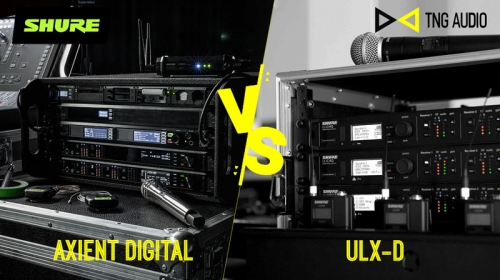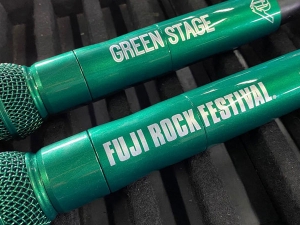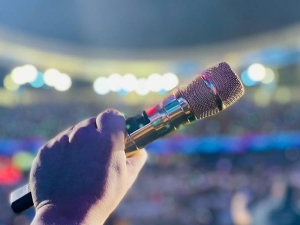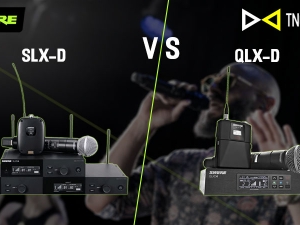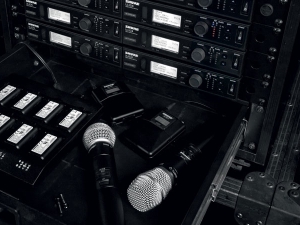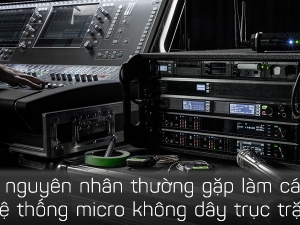Vào tháng 7 năm 2022, Shure đã vinh dự được nhận giải Emmy Kỹ thuật lần thứ 74 cho Hệ thống micro không dây Axient Digital. Axient Digital đã giúp các nhóm sản xuất âm thanh cho các chương trình truyền hình thu âm được âm thanh trong trẻo, chân thực với hiệu suất RF (tần số vô tuyến) vượt trội. Hệ t...
So sánh hai hệ thống micro không dây Shure Axient Digital và ULX-D

Cả hai hệ thống micro không dây Shure Axient Digital và ULX-D đều có nhiều tính năng mạnh mẽ và phù hợp với nhiều ứng dụng. Tuy nhiên, có sự khác biệt đáng kể giữa hai hệ thống micro chuyên nghiệp này, dẫn đến việc một hệ thống sẽ phù hợp hơn cho một ứng dụng cụ thể. Trong bài viết này, chúng ta sẽ thảo luận về những điểm giống và khác nhau của ULX-D và Axient Digital.
1. Những điểm chung

Hệ thống micro không dây Shure ULX-D rất phù hợp cho các sân khấu
- Độ trễ và tần số đáp ứng: Cả Axient Digital và ULX-D đều cung cấp độ trễ đầu cuối thấp tới 3 ms và đáp ứng tần số âm thanh đầy đủ từ 20 Hz - 20 kHz.
- Dải tần RF: Cả Axient Digital và ULX-D đều cung cấp các hệ thống hoạt động ở nhiều dải tần khác nhau (tùy theo vùng).
- Đầu vào ăng-ten từ xa: Axient Digital và ULX-D hỗ trợ kết nối các hệ thống ăng-ten từ xa được thiết kế tùy chỉnh bao gồm nhiều vùng.
- Âm thanh Dante: Cả Axient Digital và ULX-D đều có đầu ra âm thanh Dante. Với ULX-D, bạn sẽ cần bộ thu ULXD4D hoặc ULXD4Q. Đối với Axient Digital, bạn sẽ cần bộ thu AD4D hoặc AD4Q cho âm thanh kỹ thuật số Dante.
- Pin sạc: Cả hai hệ thống đều hỗ trợ pin sạc (tiêu chuẩn trên một số máy phát Axient Digital, tùy chọn trên ULX-D).
- Micro tương thích: Cả hai hệ thống đều tương thích với rất nhiều micro Shure, trong đó có cả micro cầm tay nổi tiếng SM58 và Beta 58A cũng như hầu hết các micro đeo tai và micro cài áo Shure.
- Quản lý từ xa: Cả hai hệ thống đều có thể quản lý từ xa bằng Shure Wireless Workbench 6 (ULX-D).
- Giao diện logic: Cả hai hệ thống đều có thể cung cấp thông tin cho hệ thống điều khiển của bên thứ ba thông qua giao diện Chuỗi lệnh (Command Strings).
2. Các tính năng độc đáo của ULX-D

Micro boundary (mai rùa) ULXD6 và máy phát sóng không dây cho micro cổ ngống ULX8 là giải pháp được ưa chuộng cho phòng họp
- Micro nhiều kiểu dáng: Bên cạnh các bộ phát sóng không dây cầm tay và bodypack truyền thống, ULX-D có thêm các tùy chọn bộ phát sóng không dây boundary và cổ ngỗng.
- Đầu ra tổng hợp âm thanh: Bộ thu ULX-D có đầu ra một kênh chứa âm thanh được mix từ tất cả bốn kênh của bộ thu bốn kênh ULXD4Q hoặc cả hai kênh trong bộ thu kênh đôi ULXD4D.
- Tương thích với hệ thống micro không dây QLX-D: Receiver ULX-D có thể nhận âm thanh từ một số bộ phát sóng không dây QLX-D trong một số trường hợp. Xem thêm tại: Bộ phát QLX-D có sử dụng được với bộ thu ULX-D và ngược lại không?
- Bộ thu kênh đơn: Receiver ULXD4 có thể được sử dụng cho các hệ thống nhỏ có một kênh không dây.
- Tần số không dây VHF: ULX-D và QLX-D có các bộ không dây dùng băng tần VHF (tuỳ vùng).
3. Các tính năng độc đáo của Axient Digital

Các bộ phát sóng không dây bodypack, plug-on và cầm tay không dây Shure Axient Digital đáp ứng mọi nhu cầu từ phim ảnh, sân khấu đến game show
- ShowLink: Axient Digital có các bộ phát sóng không dây body pack và micro cầm tay không dây (ADX1, ADX1M, ADX2 và ADX2FD) có thể quản lý từ xa thông qua ShowLink, cho phép tự động gán lại tần số trong khi sử dụng cũng như điều chỉnh các thông số khác. Bạn sẽ cần có ShowLink Access point AD610 và Trình quản lý phổ AXT600 để nhảy tần tự động.
- Quadversity: Bộ thu Axient Digital bốn kênh có thể được sử dụng ở chế độ Quadversity, cho phép bốn ăng-ten trên mỗi kênh.
- Đa dạng tần số: Axient Digital có khả năng phân tập tần số với một số cấu hình máy phát sóng không dây.
- Kiến trúc nhiều máy thu diversity thực: Với Axient Digital, cả hai đầu vào ăng-ten đều tích cực nhận và giải mã tín hiệu số mọi lúc. Các dòng dữ liệu kỹ thuật số sau đó được kết hợp lại với nhau.
- Receiver di động có khe cắm camera: Bộ thu ADX5D có thể kết hợp với các bộ phát Axient Digital hiện có để cung cấp âm thanh cho camera hoặc máy ghi âm di động tại hiện trường.
- Đầu ra âm thanh Analog, AES3 và Dante: Axient Digital cung cấp đầu ra AES3 ngoài Dante và Analog.
Shure

